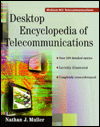Read an Excerpt
Chapter A
Advanced Intelligent Network (AIN) The Advanced Intelligent Network (AIN) provides carriers with the means to create and uniformly support telecommunications services and features via a common architectural platform. New services are created and supported through processors, software, and databases that are distributed throughout the public network. These intelligent nodes are linked via a separate high-speed messaging network called Signaling System 7 (SS7) in order to support a variety of services and advanced call-handling features across multiple vendor domains.
By accessing these intelligent nodes, users are able to design and control their own services and customize features without telephone company involvement. Of course, this statement assumes that the carriers offer such access as a customer service. To date, such services have been few and far between, causing many in the industry to believe that the full benefits of AIN have yet to be realized.
Advantages for Carriers
The AIN is a natural extension of the flexibility that is provided by the voice-oriented Virtual Private Networks (VPNs) of AT&T, MCI WorldCom, and Sprint-which have been in operation since the early 1980s.
The AIN enables carriers to offer new services to subscribers and at the same time reduce their capital investment and operating costs. Carriers also have the flexibility to design and implement new services without having to rely on traditional switching vendors in order to support these new services. Most importantly, with growing competition in local exchange markets, the AIN will provide the tools that are required by carriers in order to remain viable in acompetitive environment.
Traditionally, carriers purchased software and updates from the switch vendor and then loaded them into each switching system that provided the service. If the carrier had several different types of switches on its network, the process of introducing a new service was more cumbersome because the software upgrades had to be coordinated among the various switch manufacturers in order to ensure service continuity. This process delayed the availability of new services to some locations.
Because the services and features in an AIN are defined in software programs that are distributed among fewer locations (intelligent nodes), telephone companies can develop and enhance the network software and eliminate switch manufacturer involvement altogether. Once the carrier develops new services, it can immediately offer these services to customers via intelligent nodes that are distributed throughout the network. By accessing these nodes, customers can instantly obtain a uniform set of services for maximum efficiency and economy-even across multiple locations.
By enabling users to design, add, or change their own networks and services from a management terminal, carriers are relieved of much of the administrative burden that is associated with customer service. In turn, this functionality reduces the carrier's personnel requirements-and, consequently, reduces the cost of network operation.
Carriers also can control costs by aggregating customer demand in order to ensure full use of the network. This process would entail the centralization of infrequently used or highly specialized capabilities and the distribution of frequently used and highly shared capabilities over a wider area. The result is a more efficient utilization of network resources and lower operating costs. The distributed architecture of the AIN makes all of these results possible.
Advantages for Users
Rather than investing heavily in premises-based equipment in order to obtain a high level of performance and functionality via private networks, customers can tap into the service logic of intelligent nodes that are embedded in the public network. The service logic can be programmed to implement advanced calling features, such as interactive voice response or speech recognition and bandwidth on demand, in order to support multimedia applications. In some cases, customers are also able to design their own sophisticated hybrid networks without carrier involvement and to manage them from an on-premises terminal as though they were private networks.
AIN enables users to assemble the required resources in the form of functional components, in accordance with their design specifications. Users also can test the integrity of network models by simulation prior to implementation. Service provisioning is virtually instantaneous. Because telephone companies can activate new services quickly and easily at all network locations, users will not have to wait months or years for new services to become available to all of their locations. Users can even receive additional bandwidth within minutes of their request...



